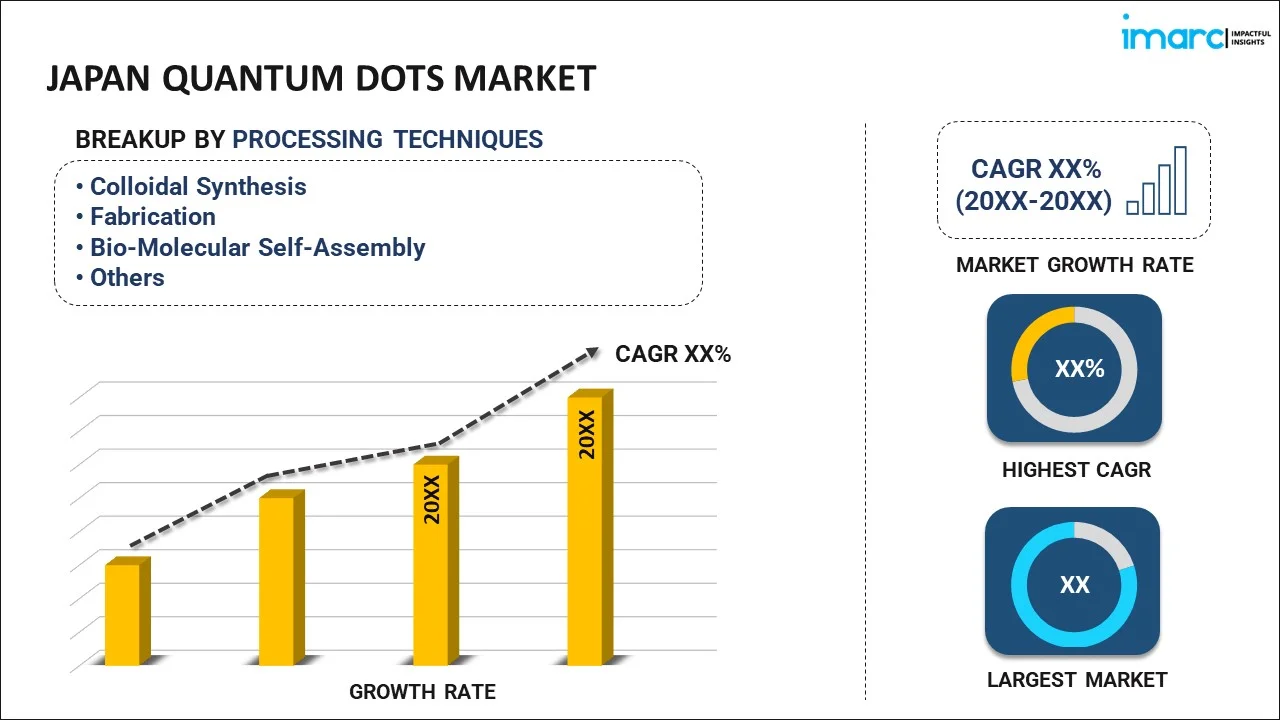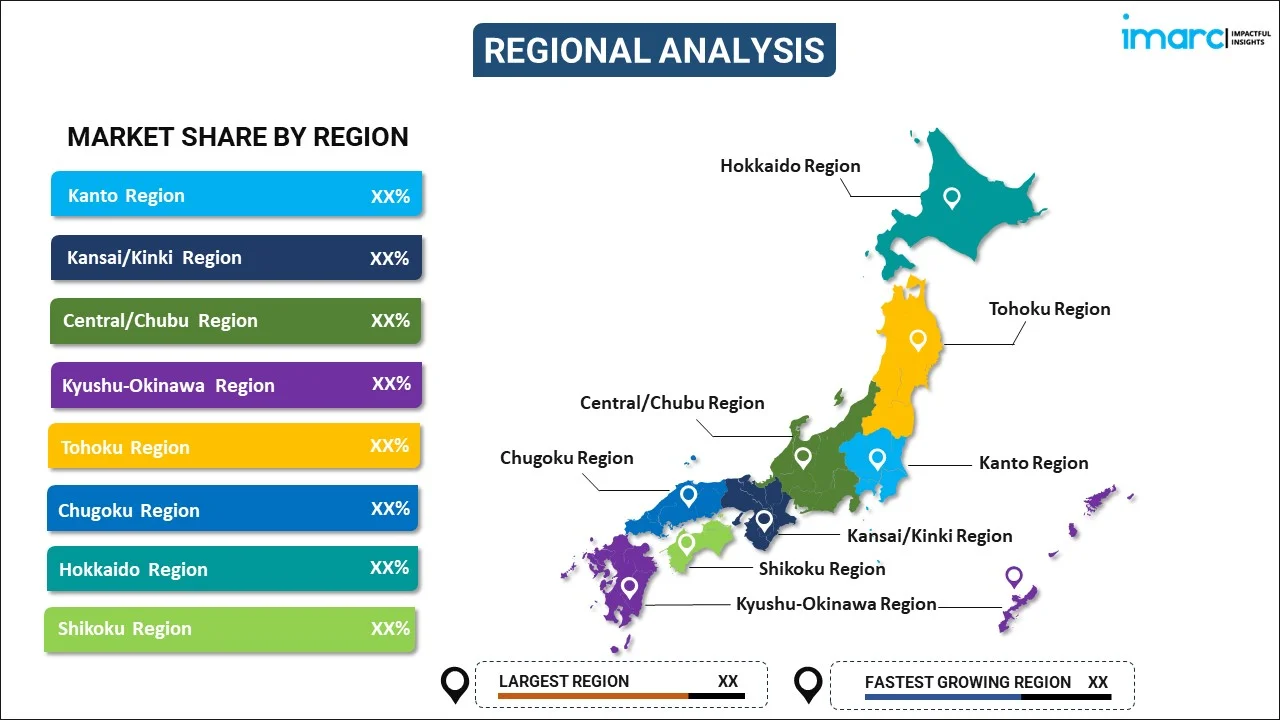
Japan Quantum Dots Market Report by Processing Techniques (Colloidal Synthesis, Fabrication, Bio-Molecular Self-Assembly, Viral Assembly, Electrochemical Assembly, and Others), Application (Medical Devices, Displays, Solar Cells, Photodetectors Sensors, Lasers, LED Lights, Batteries and Energy Storage Systems, Transistors, and Others), Material (Cadmium Based QD, Cadmium Free QD), End Use Industry (Healthcare, Optoelectronics, LED Lighting, Solar Modules, and Others), and Region 2025-2033
Market Overview:
Japan quantum dots market size reached USD 585.5 Million in 2024. Looking forward, IMARC Group expects the market to reach USD 2,086.9 Million by 2033, exhibiting a growth rate (CAGR) of 15.2% during 2025-2033. The market is being driven by significant progress in material synthesis methods, the capacity to finely adjust emission characteristics, and a growing need for superior materials offering enhanced stability.
|
Report Attribute
|
Key Statistics
|
|---|---|
|
Base Year
|
2024
|
|
Forecast Years
|
2025-2033
|
|
Historical Years
|
2019-2024
|
|
Market Size in 2024
|
USD 585.5 Million |
|
Market Forecast in 2033
|
USD 2,086.9 Million |
| Market Growth Rate 2025-2033 | 15.2% |
Quantum dots represent nanoscale semiconductor particles, typically produced through the controlled synthesis of semiconductor materials like cadmium selenide or lead sulfide. By precisely managing the size of these particles, it becomes possible to finely adjust their bandgap, enabling the emission of light at specific wavelengths. Quantum dots operate based on the principles of quantum mechanics, exploiting the confinement of electrons within a small space to create discrete energy levels, resulting in efficient light emission. Quantum dots consist of a semiconductor core responsible for light emission, along with a shell that enhances stability and governs emission properties. These remarkable nanocrystals offer a range of benefits, including high brightness, narrow emission spectra, and adjustability. Their applications span diverse fields such as displays, lighting, solar cells, and biomedical imaging.
Japan Quantum Dots Market Trends:
The Japan quantum dots market is experiencing robust growth driven by a multitude of factors aligning with global trends. One significant driver is the increasing demand for energy-efficient displays and lighting solutions, with quantum dots offering enhanced color accuracy and brightness. In the healthcare sector, the adoption of quantum dots is on the rise, particularly for bioimaging, drug delivery, and disease diagnosis applications, where their unique properties prove invaluable. Furthermore, quantum dots are finding expanded use in solar cells, where they contribute to higher energy conversion efficiency, aligning with Japan's commitment to renewable energy sources. The automotive industry in Japan is also contributing to the market's growth as quantum dots are employed for advanced displays and lighting systems, enhancing vehicle safety and aesthetics. Simultaneously, quantum dots are gaining traction in the realm of quantum computing, with Japan making strides in this emerging field, supported by substantial research and development investments by leading electronics companies. Moreover, the market benefits from the emergence of quantum dot-based sensors catering to environmental monitoring and industrial applications. Additionally, there is a growing demand for quantum dot-based photovoltaic devices and LED lighting, aligning with Japan's focus on sustainable technologies. These factors collectively will drive the expansion of the Japan quantum dots market over the forecasted period.
Japan Quantum Dots Market Segmentation:
IMARC Group provides an analysis of the key trends in each segment of the market, along with forecasts at the country level for 2025-2033. Our report has categorized the market based on processing techniques, application, material, and end use industry.
Processing Techniques Insights:

- Colloidal Synthesis
- Fabrication
- Lithography
- Electron Beam Lithography
- Soft Lithography
- Stencil Lithography
- Nanolithography
- Photopatternable Arrays
- Bio-Molecular Self-Assembly
- Viral Assembly
- Electrochemical Assembly
- Others
The report has provided a detailed breakup and analysis of the market based on the processing techniques. This includes colloidal synthesis, fabrication, (lithography, electron beam lithography, soft lithography, stencil lithography, nanolithography, and photopatternable arrays), bio-molecular self-assembly, viral assembly, electrochemical assembly, and others.
Application Insights:
- Medical Devices
- Displays
- Solar Cells
- Photodetectors Sensors
- Lasers
- LED Lights
- Batteries and Energy Storage Systems
- Transistors
- Others
A detailed breakup and analysis of the market based on the application have also been provided in the report. This includes medical devices, displays, solar cells, photodetectors sensors, lasers, LED lights, batteries and energy storage systems, transistors, and others.
Material Insights:
- Cadmium Based QD
- Cadmium Selenide
- Cadmium Sulfide
- Cadmium Telluride
- Cadmium Free QD
- Indium Arsenide
- Silicon
- Graphene
- Lead Sulfide
The report has provided a detailed breakup and analysis of the market based on the material. This includes cadmium based QD (cadmium selenide, cadmium sulfide, and cadmium telluride), and cadmium free QD (indium arsenide, silicon, graphene, and lead sulfide).
End Use Industry Insights:
- Healthcare
- Optoelectronics
- LED Lighting
- Solar Modules
- Others
A detailed breakup and analysis of the market based on the end use industry have also been provided in the report. This includes healthcare, optoelectronics, LED lighting, solar modules, and others.
Regional Insights:

- Kanto Region
- Kansai/Kinki Region
- Central/ Chubu Region
- Kyushu-Okinawa Region
- Tohoku Region
- Chugoku Region
- Hokkaido Region
- Shikoku Region
The report has also provided a comprehensive analysis of all the major regional markets, which include Kanto Region, Kansai/Kinki Region, Central/ Chubu Region, Kyushu-Okinawa Region, Tohoku Region, Chugoku Region, Hokkaido Region, and Shikoku Region.
Competitive Landscape:
The market research report has also provided a comprehensive analysis of the competitive landscape. Competitive analysis such as market structure, key player positioning, top winning strategies, competitive dashboard, and company evaluation quadrant has been covered in the report. Also, detailed profiles of all major companies have been provided.
Japan Quantum Dots Market Report Coverage:
| Report Features | Details |
|---|---|
| Base Year of the Analysis | 2024 |
| Historical Period | 2019-2024 |
| Forecast Period | 2025-2033 |
| Units | Million USD |
| Scope of the Report | Exploration of Historical and Forecast Trends, Industry Catalysts and Challenges, Segment-Wise Historical and Predictive Market Assessment:
|
| Processing Techniques Covered |
|
| Applications Covered | Medical Devices, Displays, Solar Cells, Photodetectors Sensors, Lasers, LED Lights, Batteries and Energy Storage Systems, Transistors, Others |
| Materials Covered |
|
| End Use Industries Covered | Healthcare, Optoelectronics, LED Lighting, Solar Modules, Others |
| Regions Covered | Kanto Region, Kansai/Kinki Region, Central/ Chubu Region, Kyushu-Okinawa Region, Tohoku Region, Chugoku Region, Hokkaido Region, Shikoku Region |
| Customization Scope | 10% Free Customization |
| Post-Sale Analyst Support | 10-12 Weeks |
| Delivery Format | PDF and Excel through Email (We can also provide the editable version of the report in PPT/Word format on special request) |
Key Questions Answered in This Report:
- How has the Japan quantum dots market performed so far and how will it perform in the coming years?
- What has been the impact of COVID-19 on the Japan quantum dots market?
- What is the breakup of the Japan quantum dots market on the basis of processing techniques?
- What is the breakup of the Japan quantum dots market on the basis of application?
- What is the breakup of the Japan quantum dots market on the basis of material?
- What is the breakup of the Japan quantum dots market on the basis of end use industry?
- What are the various stages in the value chain of the Japan quantum dots market?
- What are the key driving factors and challenges in the Japan quantum dots?
- What is the structure of the Japan quantum dots market and who are the key players?
- What is the degree of competition in the Japan quantum dots market?
Key Benefits for Stakeholders:
- IMARC’s industry report offers a comprehensive quantitative analysis of various market segments, historical and current market trends, market forecasts, and dynamics of the Japan quantum dots market from 2019-2033.
- The research report provides the latest information on the market drivers, challenges, and opportunities in the Japan quantum dots market.
- Porter's five forces analysis assist stakeholders in assessing the impact of new entrants, competitive rivalry, supplier power, buyer power, and the threat of substitution. It helps stakeholders to analyze the level of competition within the Japan quantum dots industry and its attractiveness.
- Competitive landscape allows stakeholders to understand their competitive environment and provides an insight into the current positions of key players in the market.
Need more help?
- Speak to our experienced analysts for insights on the current market scenarios.
- Include additional segments and countries to customize the report as per your requirement.
- Gain an unparalleled competitive advantage in your domain by understanding how to utilize the report and positively impacting your operations and revenue.
- For further assistance, please connect with our analysts.
 Inquire Before Buying
Inquire Before Buying
 Speak to an Analyst
Speak to an Analyst
 Request Brochure
Request Brochure
 Request Customization
Request Customization




.webp)




.webp)












